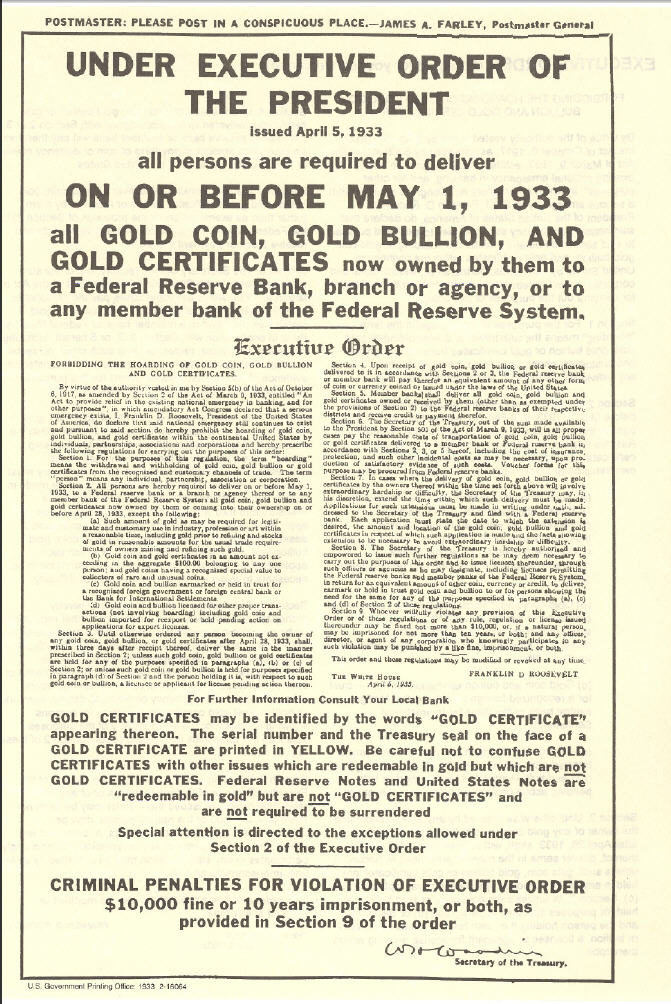Understanding Roosevelt's 1933 Gold Confiscation

In this episode of the Money Metals Midweek Memo, host Mike Maharrey delves into the topic of Franklin D. Roosevelt’s gold confiscation during the Great Depression, framed within a broader discussion of government power and individual compliance.
Personal Anecdotes and Government Compliance
Maharrey begins by relating his own childhood obedience to his mother’s rules, using this personal anecdote as a metaphor for how people generally comply with government mandates, whether out of respect, fear, or a desire to please. He asserts that, much like his mother’s hypothetical threats, the government’s power is often more implied than real, due to their limited capacity to enforce laws against a non-compliant populace.
Executive Order 6102: Context and Purpose

Mike Maharrey discussed Franklin D. Roosevelt’s Executive Order 6102, issued on April 5, 1933, which required U.S. citizens to surrender much of their gold holdings to the Federal Reserve. The order was justified as a necessary measure to stabilize the U.S. banking system during the Great Depression, following a severe bank run that prompted Roosevelt to declare a bank holiday.
Key Aspects of Executive Order 6102:

- Purpose of the Order: The executive order was framed as a measure to prevent the hoarding of gold, which was seen as exacerbating the banking crisis by leading to a shortage of gold reserves necessary to back the currency. This was part of a broader strategy to prevent gold from flowing out of the banking system and to enable the Federal Reserve to inflate the money supply.
- Compensation for Gold: Citizens turning in their gold were not robbed outright; they were compensated with paper currency at the rate of $20.67 per ounce. Maharrey emphasizes that this exchange rate was set by law, suggesting that the transaction was not confiscation in the traditional sense but rather a mandatory buy-back.
- Legal and Social Dynamics: The order was legally grounded in the Trading with the Enemy Act of 1917, as amended by the Emergency Banking Act of 1933. Maharrey discusses how Roosevelt’s administration used the language of “hoarding” to morally charge the act of holding gold, painting it as unpatriotic and antisocial during a national crisis.
- Public Compliance and Enforcement: Maharrey points out that the effectiveness of the executive order relied heavily on voluntary compliance. He noted that there was no widespread forceful confiscation or aggressive enforcement. Most people who complied did so out of a sense of duty or fear of legal consequences, which included hefty fines or imprisonment.
- Impact and Aftermath: The immediate effect was to increase the gold reserves of the Federal Reserve, allowing for more paper money to be printed. Later, the U.S. moved further away from the gold standard, culminating in significant monetary policy shifts. Maharrey also mentions that the executive order was followed by the Gold Reserve Act of 1934, which adjusted the price of gold from $20.67 per ounce to $35 per ounce and further consolidated gold in federal hands, allowing even more flexibility in monetary expansion.
Maharrey’s discussion of Executive Order 6102 is critical yet nuanced, acknowledging both the context of its implementation and its implications for personal freedoms and government power.
Maharrey explains this order was a means to bolster the federal gold reserves, which would allow the government to increase the money supply, aiming to alleviate the economic strains of the Depression while increasing government spending and centralized power. He challenges the common perception of this move as a wholesale “confiscation,” clarifying that most people complied voluntarily and were compensated at the then-standard gold price of $20.67 per ounce.
According to Milton Friedman and Anna Schwartz in their book, A Monetary History of the United States 1867-1960, the amount of gold turned in following Executive Order 6102 was relatively small. Friedman and Schwartz estimate that only about 20 to 25% of the gold held in private hands was actually surrendered to the Federal Reserve. This suggests that the majority of people, approximately 75 to 80%, chose to ignore the order and retained their gold privately.
Furthermore, Maharrey discusses the aftermath and the broader implications of the gold confiscation, including the eventual rise of the dollar value of gold to $35 per ounce in 1934, which effectively increased the gold value on the Federal Reserve’s balance sheet by 69%. This allowed for further expansion of the money supply under the gold standard.
Theoretical Underpinnings and Modern Parallels

Towards the end of the podcast, Maharrey touches on modern parallels, noting how the Federal Reserve and the federal government manipulate the money supply today without the constraints of the gold standard. He concludes by encouraging listeners to consider buying gold and silver as a safeguard against potential economic instability, emphasizing the ongoing relevance of precious metals as “real money.”
The Importance of Sound Money
Mike Maharrey touches on the concept of sound money primarily through the historical context of the U.S. gold standard and its implications for today’s monetary policy. He discusses how, historically, sound money was represented by currency backed by physical gold, which limited the government’s ability to expand the money supply arbitrarily.
Maharrey explains that the gold standard acted as a check on the government’s ability to inflate the currency, as the Federal Reserve was required to hold gold reserves equal to at least 40% of the currency it issued. This requirement constrained monetary policy, but it was circumvented by Roosevelt’s actions in the 1930s, which shifted gold from private hands to the Federal Reserve, thus allowing for an increase in paper money circulation.
He also reflects on the modern implications of departing from sound money principles, particularly highlighting the Federal Reserve’s current ability to expand the money supply without such constraints, leading to significant economic repercussions like inflation.
Maharrey emphasizes the importance of sound money for economic stability and advocates for the ownership of physical gold and silver as a way to retain personal control over part of one’s financial assets in a landscape where government actions can dilute traditional money’s value.
Overall, Maharrey advocates for a return to sound money principles to limit government power over the economy and protect individual financial sovereignty.
Conclusion and Call to Action

Throughout the episode, Maharrey engages with historical facts, economic theories, and personal insights to argue that government actions often rely heavily on the voluntary compliance of its citizens, and he encourages a more questioning and cautious approach to governmental power and monetary policies.
The episode concludes with Maharrey advocating for the purchase of gold and silver as a hedge against potential economic downturns, suggesting that owning physical precious metals is a prudent way to maintain personal financial security in uncertain economic times.
Anyone can join.
Anyone can contribute.
Anyone can become informed about their world.
"United We Stand" Click Here To Create Your Personal Citizen Journalist Account Today, Be Sure To Invite Your Friends.
Lion’s Mane Mushroom
Mushrooms are having a moment. One fabulous fungus in particular, lion’s mane, may help improve memory, depression and anxiety symptoms. They are also an excellent source of nutrients that show promise as a therapy for dementia, and other neurodegenerative diseases. If you’re living with anxiety or depression, you may be curious about all the therapy options out there — including the natural ones.Our Lion’s Mane WHOLE MIND Nootropic Blend has been formulated to utilize the potency of Lion’s mane but also include the benefits of four other Highly Beneficial Mushrooms. Synergistically, they work together to Build your health through improving cognitive function and immunity regardless of your age. Our Nootropic not only improves your Cognitive Function and Activates your Immune System, But it benefits growth of Essential Gut Flora, further enhancing your Vitality.
Our Formula includes:
Lion’s Mane Mushrooms which Increase Brain Power through nerve growth, lessen anxiety, reduce depression, and improve concentration. Its an excellent adaptogen, promotes sleep and improves immunity.
Shiitake Mushrooms which Fight cancer cells and infectious disease, boost the immune system, promotes brain function, and serves as a source of B vitamins.
Maitake Mushrooms which regulate blood sugar levels of diabetics, reduce hypertension and boosts the immune system.
Reishi Mushrooms which Fight inflammation, liver disease, fatigue, tumor growth and cancer. They Improve skin disorders and soothes digestive problems, stomach ulcers and leaky gut syndrome.
Chaga Mushrooms which have anti-aging effects, boost immune function, improve stamina and athletic performance, even act as a natural aphrodisiac, fighting diabetes and improving liver function.
Try Our Lion’s Mane WHOLE MIND Nootropic Blend 60 Capsules. Today Be 100% Satisfied Or Receive A Full Money Back Guarantee Order Yours Today By Following This Link.






